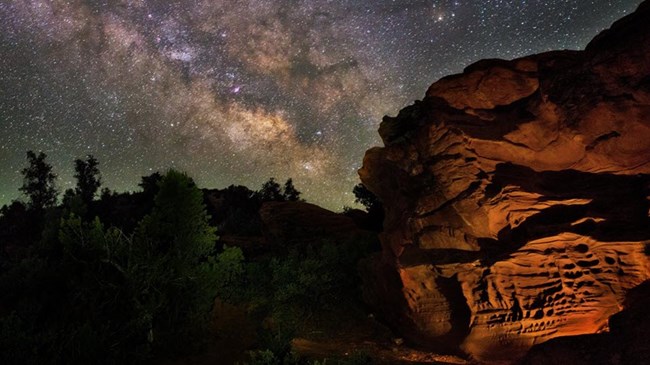
NPS Photo
Grand Canyon-Parashant National Monument was established in 2000 and is managed jointly by the Bureau of Land Management and the National Park Service.
Located in the northwest corner of Arizona where the Mojave Desert and Colorado Plateau ecoregions meet, the park has expansive geological, elevational, and ecological diversity. Parashant spans more than one million acres and is one of the most rugged and remote landscapes remaining in the southwestern United States. The monument provides iconic western vistas in a setting known for its solitude, silence, night skies, and wilderness.
The Mojave Desert Network provides natural resource inventory and monitoring information to help parks make effective, science-based management decisions. Inventories have been completed for mammals, fish, birds, vascular plants, and reptiles & amphibians (see species lists further down the page). Maps and reports detailing Parashant's vegetation, soils, and geology resources are also complete.
Monitoring at Grand Canyon-Parashant National Monument
Ongoing Monitoring Efforts
Aspen monitoring aspen stands
Bats monitoring bat populations using acoustic and capture surveys
Desert Springs monitoring water quality and availability at nearly 50 smaller seeps and springs
Integrated Uplands vegetation and soils monitoring of the sagebrush community
Invasive & Exotic Plants monitoring plan for detecting invasive plants throughout the Park
Selected Large Springs monitoring water quality and availability at Pakoon Spring and Tassi Spring
Spring Vegetation monitoring desert spring plant communities at select springs
Weather and Climate monitoring temperature, precipitation, wind and other variables at park service and partner weather stations
Reports & Publications
Inventories & Assessments present baseline data collected during the first phase of the development of the Mojave Desert Inventory & Monitoring Network in order to have comparison with the long-term monitoring data currently being collected. Monitoring protocols describe why and how we collect, manage, analyze, and report monitoring data about the network's Vital Signs. The protocols consist of a narrative and associated set of standard operating procedures (SOPs). Monitoring Reports summarize data and findings from our Vital Signs monitoring activities.
Source: NPS DataStore Collection 4376 (results presented are a subset). To search for additional information, visit the NPS DataStore.
Source: NPS DataStore Collection 4378 (results presented are a subset). To search for additional information, visit the NPS DataStore.
Source: NPS DataStore Collection 4380 (results presented are a subset). To search for additional information, visit the NPS DataStore.
Source: NPS DataStore Collection 4379 (results presented are a subset). To search for additional information, visit the NPS DataStore.
Select a Park:
Select a Species Category (optional):
Visit NPSpecies for more comprehensive information and advanced search capability. Have a suggestion or comment on this list? Let us know.
Last updated: December 2, 2024
